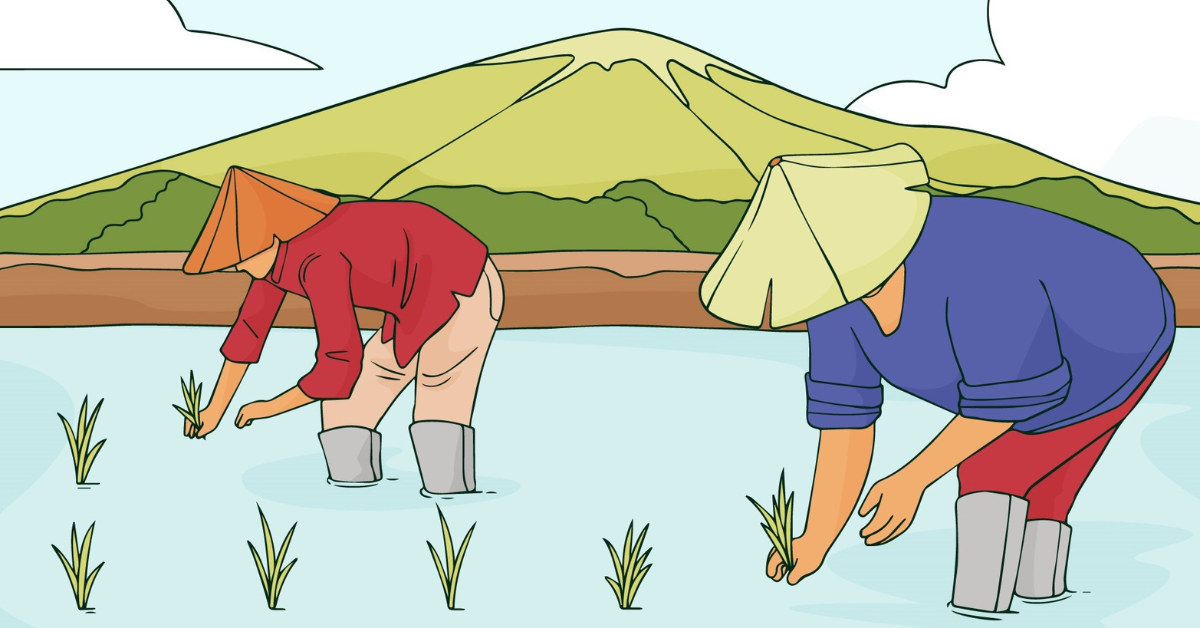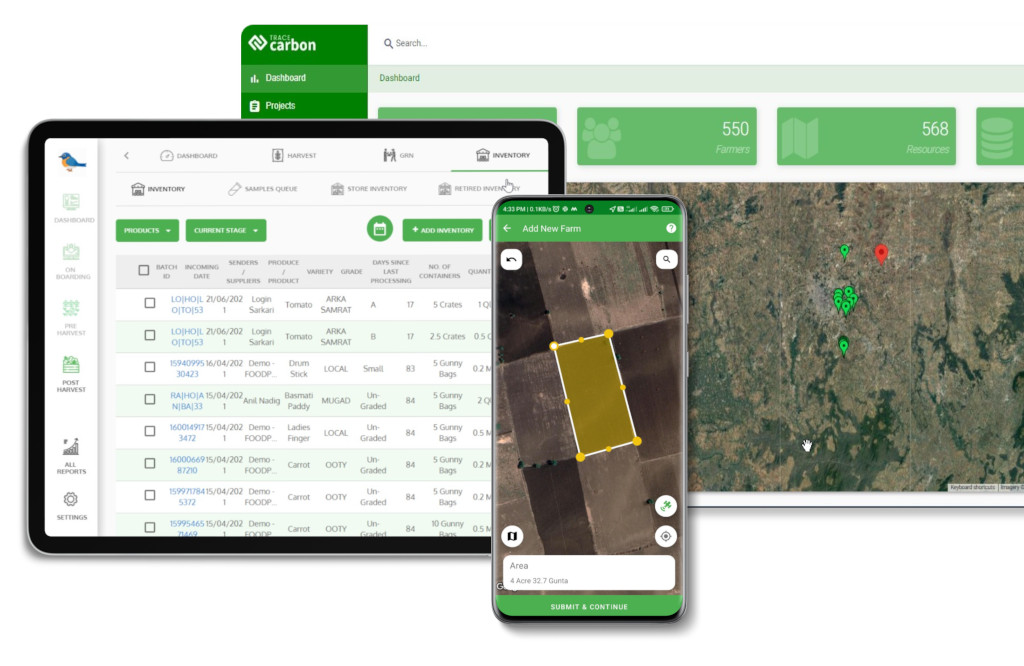Contact: +91 99725 24322 |
Menu
Menu
Quick summary: Discover how sustainable rice farming in the Philippines enhances food security, climate resilience, and farmer livelihoods. Learn about eco-friendly practices and traceability solutions for a greener rice industry.

Did you know that the Philippines is one of the world’s largest rice consumers, yet it still imports millions of metric tons of rice every year? Despite being an agricultural powerhouse, the country’s rice farmers face shrinking yields, rising input costs, and the growing threat of climate change. Traditional rice farming in Philippines is no longer sustainable.
Rice farming is the source of income and employment of 11.5 million farmers and family members.
Excessive water usage, reliance on chemical fertilizers, and unpredictable weather patterns make it difficult for farmers to maintain profitability. Many struggle with low yields and unstable market prices, forcing them to take on debt or abandon farming altogether. Without a shift to sustainable rice farming in the Philippines, the country risks long-term food insecurity, environmental degradation, and economic instability for thousands of smallholder farmers.
Smart farming techniques, digital traceability, and regenerative agriculture offer solutions that can boost both productivity and sustainability. Let’s explore proven strategies and innovations that can transform the future of rice farming.
Key Takeaways
Rice is the staple food of the Philippines, but for many farmers, growing it has become more of a struggle than a livelihood. Despite their hard work, many rice farmers face challenges that threaten their productivity and income. Let’s break them down:
For years, many farmers have relied heavily on chemical fertilizers and pesticides to boost yields. But here’s the problem—these inputs are expensive, and over time, they degrade soil health, making crops even more dependent on synthetic chemicals. The result? Higher costs, lower soil fertility, and weaker plants that are more vulnerable to pests and diseases.
Rice farming is water-intensive, but many farmers still use traditional flood irrigation methods, which waste huge amounts of water. With unpredictable rainfall and increasing droughts, inefficient water use puts farms at risk of low yields and complete crop failure.
What’s the alternative? Technologies like Alternate Wetting and Drying (AWD) and drip irrigation can reduce water use while maintaining high yields.
The biggest challenge rice farmers face today is climate change. Rising temperatures, stronger typhoons, and irregular rainfall patterns make it harder to plan the planting and harvesting cycles. A sudden drought or unexpected storm can wipe out an entire season’s crop, leaving farmers with little to no income.
Example: Typhoon Odette in 2021 destroyed thousands of hectares of rice fields, pushing many smallholder farmers into debt.
Despite all their hard work, many farmers earn barely enough to cover costs. The cost of seeds, fertilizers, and labor keeps rising, but farmgate prices remain low. Middlemen often take a large cut, leaving farmers with minimal profit. Without access to better markets and fair pricing, many small farmers are trapped in a cycle of poverty.
What’s the solution? Direct market access, organic certification, and blockchain-powered traceability can help farmers get fairer prices for sustainable rice.
Rice farming in the Philippines needs a shift toward sustainability—better water management, reduced reliance on chemicals, climate-smart practices, and direct farmer-to-market connections. With the right technology and strategies, rice farmers can increase yields, lower costs, and secure a more stable future for themselves and the industry.
Rice farming is the backbone of Philippine agriculture, but with rising costs, unpredictable weather, and environmental concerns, farmers are looking for smarter, more sustainable ways to grow rice. The good news? There are proven techniques that increase yields, reduce costs, and protect the environment.
Water is a farmer’s most valuable resource, yet traditional rice farming uses too much of it. The Alternate Wetting and Drying (AWD) method helps conserve water while maintaining productivity.
How it works: Instead of keeping fields continuously flooded, AWD allows the soil to dry between irrigation cycles. Farmers use a simple water tube to measure moisture and irrigate only when needed.
✔ Saves up to 30% of water without affecting yield.
✔ Prevents methane emissions, making farms eligible for carbon credits.
✔ Reduces production costs by lowering water and fuel expenses for irrigation.
VNV leverages TraceX’s traceability solutions to efficiently implement AWD techniques, ensuring sustainable water management and improved rice production.
Over-reliance on synthetic fertilizers and pesticides depletes soil health over time, forcing farmers to spend more on inputs. The solution? Organic and regenerative farming methods that bring the land back to life.
How to do it:
✔ Use compost, cover crops, and natural fertilizers to rebuild soil nutrients.
✔ Reduce chemical use by introducing integrated pest management (IPM) techniques.
✔ Rotate rice crops with leguminous plants to improve soil fertility naturally.
Why it matters: Healthier soil leads to better crop resilience, reduced input costs, and higher market value for organically grown rice.
Farmers no longer have to rely on guesswork to manage their crops. Smart farming technologies use real-time data to optimize fertilization, irrigation, and pest control.
How technology helps rice farmers:
✔ IoT sensors monitor soil moisture, temperature, and weather conditions.
✔ AI-driven analytics predict crop diseases and recommend the best planting schedules.
✔ Drones and satellite imaging provide large-scale farm monitoring and spray inputs more efficiently.
Climate change is one of the biggest threats to rice farming. By adopting climate-smart techniques, farmers can increase resilience while reducing their carbon footprint.
Key strategies for carbon-smart rice farming:
✔ Implement the System of Rice Intensification (SRI), which boosts yield with fewer resources.
✔ Use low-emission farming techniques like AWD to reduce methane emissions.
✔ Participate in carbon credit programs, where farmers earn income by reducing greenhouse gas emissions.
Rice farming in the Philippines is evolving. With climate change, water scarcity, and increasing production costs, farmers need smarter ways to grow more with less. This is where technology steps in—helping farmers track their crops, optimize yields, and improve sustainability.
Let’s explore how technology is transforming rice farming and making it more profitable and sustainable for Filipino farmers.
Consumers today want to know where their rice comes from—whether it’s ethically grown, pesticide-free, or produced using sustainable methods. Blockchain technology allows farmers and cooperatives to digitally record every step in the rice supply chain, ensuring complete transparency.
How It Helps Farmers & Exporters:
✔ Farm-to-market traceability—buyers can verify if rice was grown using sustainable practices.
✔ Prevents fraud & mislabeling—ensures only authentic, sustainably grown rice reaches the market.
✔ Increases market access—buyers, especially in Europe and the U.S., prefer verified sustainable rice.
A major agribusiness exporter spearheaded the digitization of its Sustainable Rice Project, with a focus on Basmati paddy cultivation across regions in Haryana.
“We were able to connect our complete ecosystem by partnering with TraceX to implement a blockchain-powered digital agricultural platform. We were able to track data in structured forms as well as receive real-time updates on our farms, which really helped us in taking right decision at right time.”
Farmers have always relied on experience to decide when to plant, how much water to use, or which fertilizer works best. But now, AI and data analytics make these decisions even more accurate and efficient.
How AI Helps Farmers:
✔ Predicts weather patterns & soil conditions—avoids crop losses due to unexpected droughts or floods.
✔ Optimizes fertilizer & water use—reduces waste, cutting costs by up to 20%.
✔ Detects crop diseases early—saves crops before they are severely affected.
Instead of guessing when to water or fertilize crops, farmers can now use satellite data and IoT (Internet of Things) sensors to monitor farm conditions in real-time. These tools provide instant alerts about soil health, pest activity, and irrigation needs, making farm management more precise and less labor-intensive.
How It Works:
✔ IoT sensors track water levels & soil moisture—ensuring optimal irrigation while reducing waste.
✔ Satellite imaging detects crop health issues before they become serious.
✔ Drones can be used for precision spraying, reducing pesticide overuse and improving efficiency.

TraceX offers an end-to-end digital farm management and dMRV (Digital Measurement, Reporting, and Verification) platform designed to track, verify, and quantify sustainable farming practices. It enables farmers, cooperatives, agribusinesses, and food brands to monitor their supply chains, ensure compliance, and measure environmental impact with data-backed insights.
Farm Management: Digitally manages farm activities, traceability, and sustainability efforts.
dMRV for Carbon & Sustainability Tracking: Monitors sustainable farming practices and quantifies carbon reduction for climate impact verification.
TraceX’s dMRV platform provides accurate measurement and verification of sustainability initiatives. It ensures that climate-positive agricultural practices are scientifically quantified and certified for carbon markets.
Sustainable rice farming is not just the responsibility of farmers—it’s a shared effort between businesses, consumers, and investors. By making conscious choices, we can support eco-friendly farming, protect natural resources, and ensure better livelihoods for farmers.
Businesses have a huge role in driving sustainable rice farming forward. The way they source rice impacts farmers, the environment, and food security.
As consumers, our purchasing choices matter. Every time we buy rice, we’re either supporting sustainable farming or contributing to environmental harm. Here’s how to make better choices:
Sustainable rice farming needs financial and technological support to scale. Investors, agritech startups, and policymakers can accelerate the adoption of climate-smart practices.
Sustainable rice farming in the Philippines is key to ensuring food security, environmental conservation, and farmer livelihoods. By adopting climate-smart practices, digital traceability, and water-efficient techniques, farmers can enhance productivity while reducing their environmental impact. As global demand for sustainably sourced rice grows, investing in eco-friendly farming methods strengthens both local economies and international market access. The future of rice farming is sustainable—let’s grow it together.
Sustainable rice farming includes alternate wetting and drying (AWD), organic fertilizers, biodiversity-friendly pest control, and digital traceability for transparency.
It improves soil health, reduces water use by up to 30%, increases resilience to climate change, and enhances income opportunities through premium markets.
Digital traceability platforms, satellite monitoring, and blockchain-based supply chain solutions ensure transparency, reduce waste, and help farmers access sustainable certification programs.
